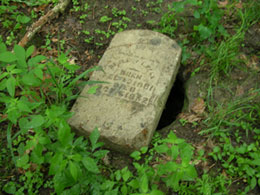Main Content
Article
Cemeteries

A fallen grave stone
Brown County, IN
Cemeteries have been a part of our cultural landscape as long as people have lived in Indiana. The size, ornamentation, and documentation of these grounds vary with religious affiliation, cultural group, the wealth of families, and the situation surrounding the person’s death. Native American burial practices varied widely depending on the time period, cultural group, and family beliefs. Both historic cemeteries and prehistoric burial areas can be found in every Indiana County.
Stones Talking to Us:
As we buried our loved ones, and markers were set, we often engrave the tombstone with symbols that have religious, cultural, or personal meaning. We can learn about individuals, society, period folk art, religious specific burials, Native American burial sites, and historical trends just by looking in the cemetery. In Bedford, Lawrence County Indiana the Green Hill Cemetery has wonderful examples of folk art. A great number of stone carvers lived and worked in Bedford. The Indiana limestone was abundant there and these carvers were adept at working with the material. The gravestones include intricate tree stump markers, large monuments, and life size monuments of individuals. One of the life size monuments includes a man with his golf clubs, while another remembers the deceased man as he was during World War I as a US soldier. Some cemeteries offer more than esthetic beauty. Cemeteries offer a view to the past through the study of the inscriptions, monuments, and related records. The stones provide a valuable resource for historical research. Cemeteries can teach us about those who came before us and what was important to these people. For many individuals early in our country’s existence, their burials and subsequent markers are the only records that exist about them. In Jeffersonville, Clark County Indiana there are examples of cemeteries with graves of enslaved Africans. Some of the grave markers list only a first name and the word “slave.” Once the marker is lost, all reference to these individuals is gone.
Using Cemeteries To Teach:
We are excited to learn about those teachers using cemeteries as a teaching resource. By teaching our youth about the historical importance of these sites, we are helping to protect them in the future. Below is a list of lesson plans to help educators use cemeteries as a resource in a variety of disciplines.
From looking at grave markings to obituary files, teachers can learn how to incorporate these local resources into their classroom.
This project is working to identify the Jewish cemeteries throughout the world.
This project works to identify African American graves, their history, and unique cultural expression found in historic Black cemeteries.
The History Channel offers a Save Our History project guide detailing a student project using a cemetery as a research tool to gather information about local and national history.
Click here to download the project guide.
